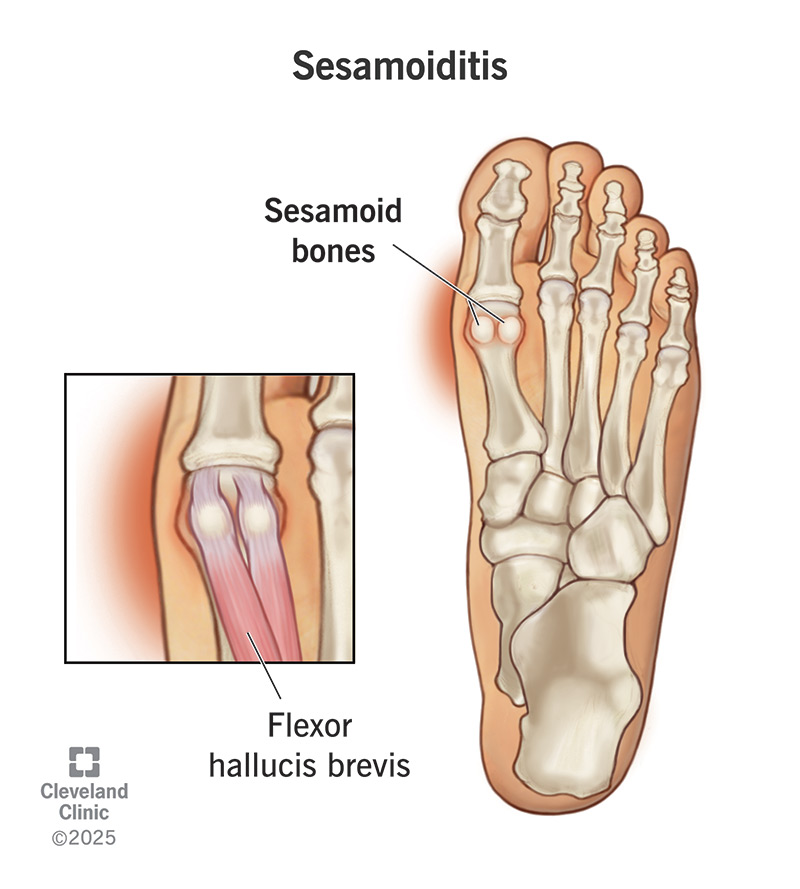Sesamoiditis is inflammation of the sesamoid bones in the ball of your foot and the tendons they’re embedded in. Overuse usually causes it — especially in dancers, runners and athletes who frequently bear weight on the balls of their feet. It’s treated with rest and anti-inflammatory medications.
Advertisement
Cleveland Clinic is a non-profit academic medical center. Advertising on our site helps support our mission. We do not endorse non-Cleveland Clinic products or services. Policy

Sesamoiditis is a common cause of pain in the ball of your foot (metatarsalgia). Your sesamoids are two tiny bones embedded in the tendons in your forefoot, just under your big toe joint (first metatarsal joint). These bones help absorb shock and stress when you put weight on your foot. Sesamoiditis means one or both of these bones are irritated and inflamed, along with the tendons they’re embedded in.
Advertisement
Cleveland Clinic is a non-profit academic medical center. Advertising on our site helps support our mission. We do not endorse non-Cleveland Clinic products or services. Policy
This makes sesamoiditis kind of an enhanced type of tendonitis, with small bones inflamed inside your tendons. Foot tendonitis is usually a repetitive strain injury, and sesamoiditis is no different. It usually happens gradually, from activities that put repetitive stress on your sesamoids. Frequent running, dancing or walking in high heels are common causes. Your foot will need time and rest to recover.
Sesamoiditis symptoms may include:
Sesamoiditis usually develops slowly. You might notice a dull ache under your big toe that builds or gets sharper over time. You’ll notice it most when you’re using your foot, and it might go away at other times.
Repetitive strain on one or both of your sesamoid bones usually causes sesamoiditis. Runners, ballet dancers and athletes get it from over-practicing movements that transfer weight to the balls of their feet. If you often wear high heels, or you have high arch feet or bunions that affect how you walk, you might get it from walking. Occasionally, other diseases or conditions can lead to sesamoiditis, such as:
Advertisement
When you put weight on the ball of your foot, tendons in your foot flex to bear the weight and perform different movements. On the big toe side, these tendons glide over your sesamoid bones when they move, using them for leverage. So, strain on these tendons directly affects your sesamoids. Weight and force can also affect the bones directly. In severe cases, repetitive stress can cause a stress fracture.
To diagnose sesamoiditis, a healthcare provider will ask about your symptoms and then carefully examine your foot. They’ll look for signs of tenderness and inflammation around your sesamoid bones. They’ll gently move your big toe joint to see if movement causes pain. They might also move the joint in a way that simulates how it works when you’re walking. This is called the passive axial compression test.
Your provider might want to take imaging tests of your foot to check for a fracture or other injuries.
These tests might include:
Treatment for sesamoiditis mostly consists of rest and self-care. You might benefit from some hands-on therapy techniques. Severe or chronic sesamoiditis might need additional medical or surgical care.
Your treatment plan may include:
In most cases, sesamoiditis should begin to improve immediately when you stop putting stress on that part of your foot. Rest gives your tissues the chance to repair from damage. Mild cases may resolve within days, while more severe cases may take months to fully heal. It’s rare to need surgery for sesamoiditis. But if your symptoms fail to improve with time and care, surgery can bring relief.
Advertisement
The tricky part will be to safely resume the activities that caused sesamoiditis. Follow your healthcare provider’s guidance on this, as well as your own body signals. Sesamoiditis can always occur again. It can also do permanent damage to your bones and tendons if you don’t allow it to fully heal or if you wait too long to seek treatment. You can avoid this by listening to your body and practicing preventive care.
If you’re prone to sesamoiditis, you can reduce your risk by reducing the factors that contribute to it.
For example:
Advertisement
Repetitive stress injuries like sesamoiditis occur when you ignore our body’s smaller stress signals until it decides to crank up the volume. When it gets to that point, you’ll regret it — especially if it means a long recovery period avoiding your usual activities. You can prevent this by paying attention to your pain signals and resting your feet after working them hard. If pain persists, seek treatment sooner than later.
Advertisement
An aching foot or heel can bring your favorite activities to a halt. Cleveland Clinic’s foot pain experts are here to help you heal and get back on your feet.

Last reviewed on 07/26/2025.
Learn more about the Health Library and our editorial process.